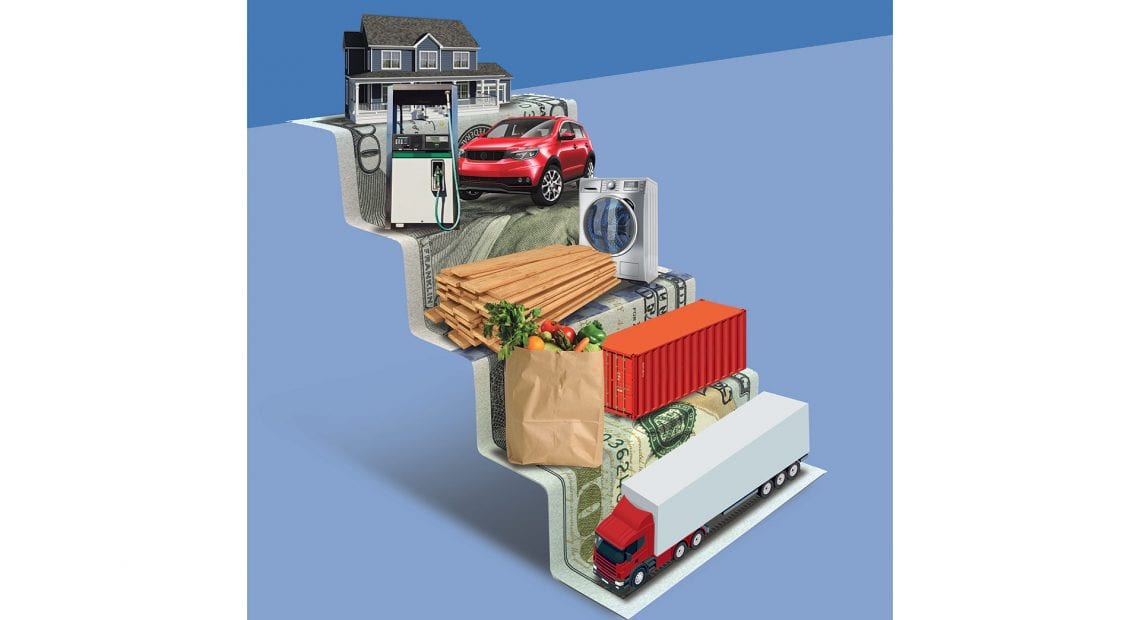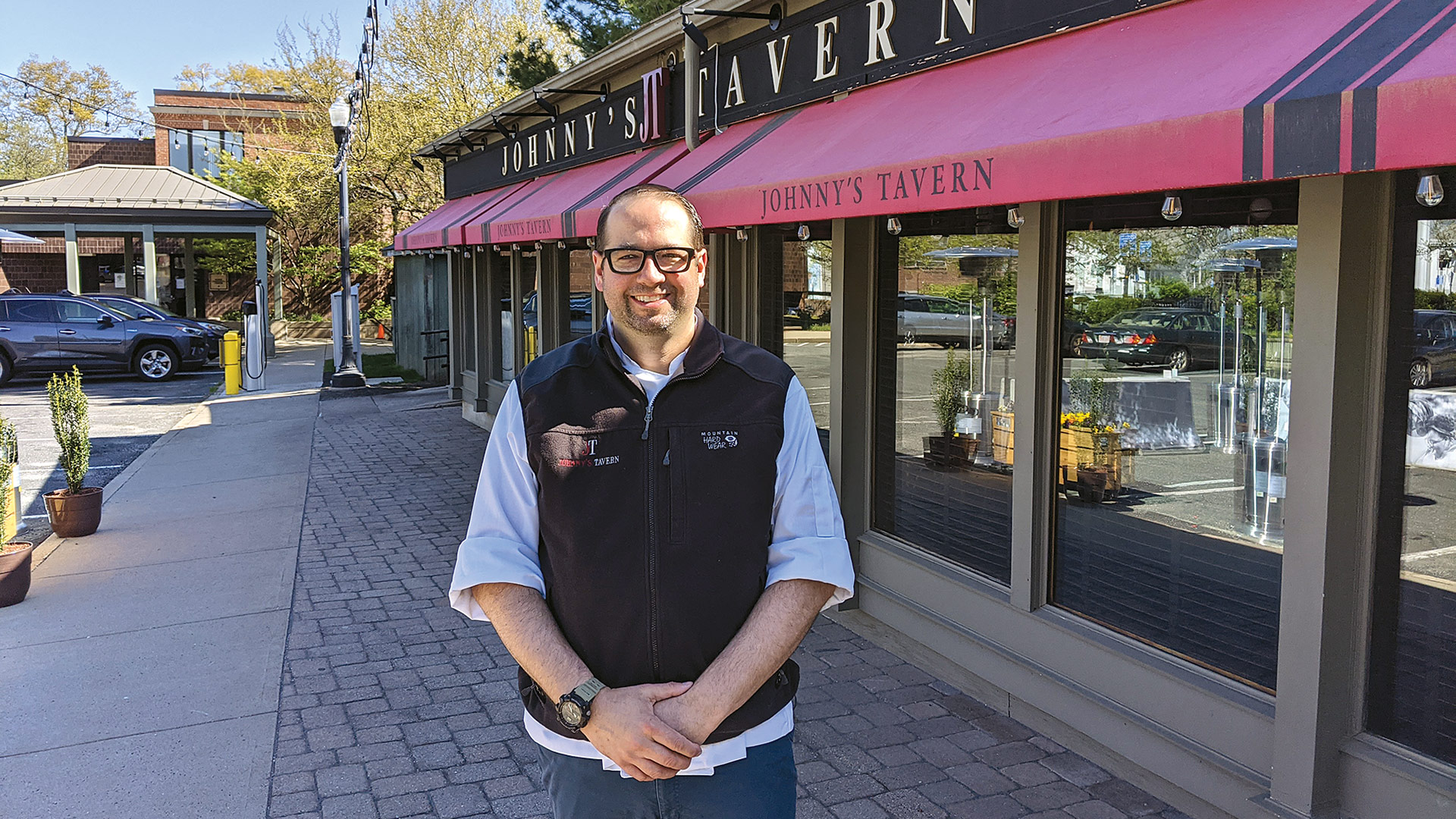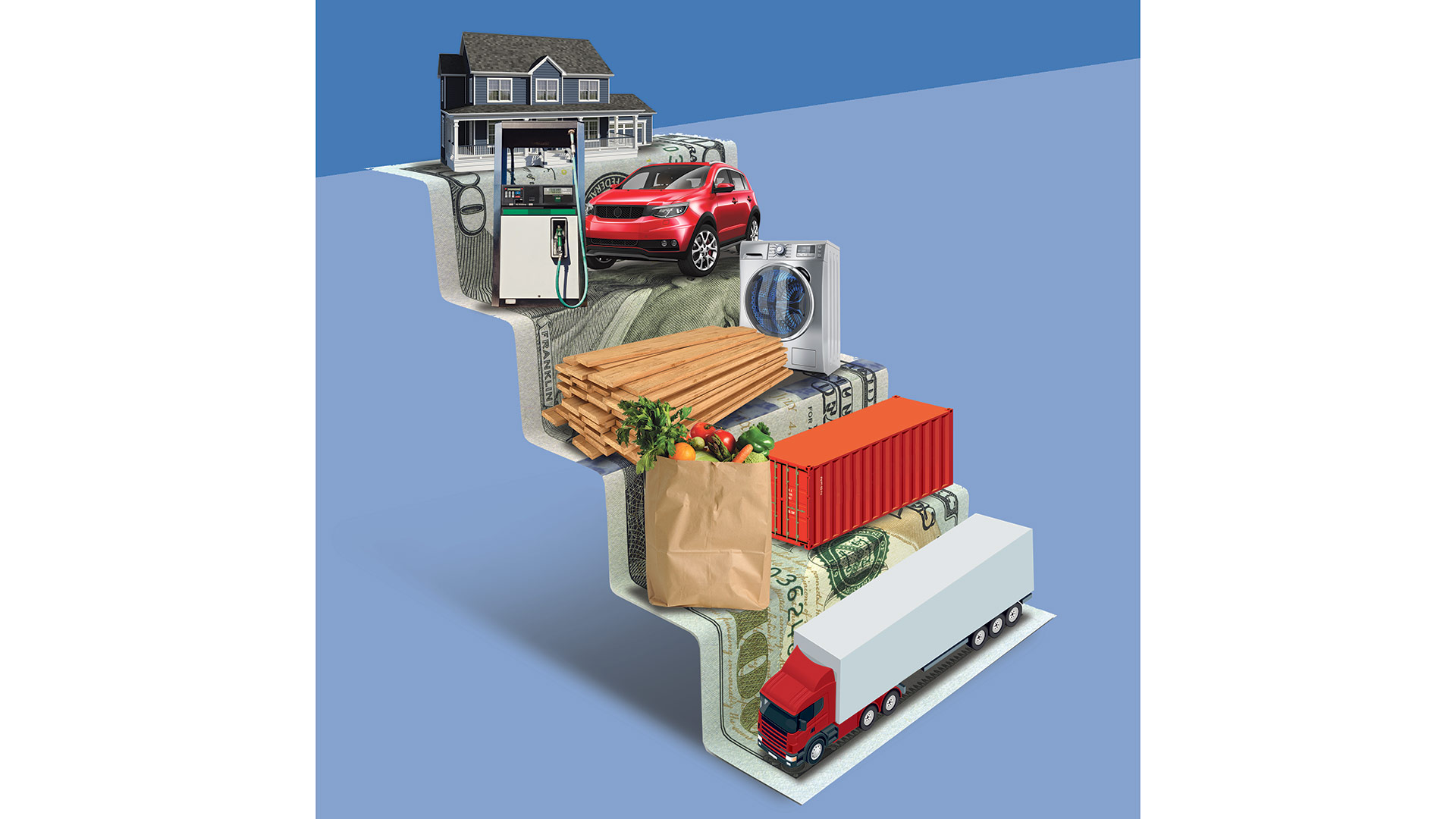
The Economic Factors Affecting Supply, and What They Mean for Businesses
The Rising Cost of … Everything
To understand what’s happening in today’s global economy, one UMass economist said it’s helpful to picture it as a grid filled with connected nodes. When one of those nodes — manufacturing, distribution, shipping, you name it — is disrupted, the impact is felt by everyone. These days, those disruptions are occurring across the supply chain, and for many different reasons, causing costs to soar — both for businesses and their customers. It’s a major concern with no simple solution, and some worry that rising prices may derail what is otherwise looking like an economy in recovery.
When people sit down at a restaurant, Bryan Graham says, they don’t usually consider how their favorite meals and ingredients get there. They just expect them to be there.
It’s not always a smooth process, and the last couple months, especially, have been a challenge.
“There have been shortages on everything — things you wouldn’t think about, everything from the beverage side to the food side,” said Graham, regional manager for the Bean Restaurant Group, which boasts a family of 11 eateries throughout the region, from Johnny’s Tavern in Amherst to the Boathouse in South Hadley to the Student Prince in Springfield.
And those shortages have a financial impact, he went on. “Increases in prices have gone through the roof — to the point where we’ve moved some things off the menu because we can’t keep up with the prices; we’re losing money.”
The company has taken to switching menu items or brands of ingredients to keep up with price fluctuations, Graham added. “We’d always purchase one brand of canned tomatoes or one brand of ketchup, but we’re seeing brands being short, so we have to switch brands to get by without running out of product day to day.”
It makes for an odd market, he said. “You place your order, and you don’t really know if it’s all coming in until you open the truck and you’re short one or two items.”
It’s not something customers typically notice — until their favorite appetizer is suddenly unavailable. “Ninety percent of our customers are really understanding. The other 10% are like, ‘what do you mean I can’t have this?’ Unfortunately, we don’t want to charge you $40 for 10 chicken wings. Most people are pretty good about it.”

Bryan Graham says high food prices have forced the occasional menu change because the Bean Restaurant Group doesn’t want to pass exorbitant costs to customers.
Nationally, food prices rose 0.4% in April, both at restaurants and on grocery shelves. Prices are up 2.4% from May 2020.
But it’s not just food. Rising prices for … well, almost everything have become one of the leading economic stories of 2021. One reason is a positive of sorts — the economy is reopening at high speed. Unfortunately, in some cases, supply chains have been slow to respond to growing consumer demand.
For example, American steel manufacturers all but shut down production last spring as the pandemic took hold and the economy imploded. But as the recovery ramped up, mills were slow to resume full production, creating a massive steel shortage, one that has severely impacted building costs.
Meanwhile, sawmills also shut down lumber production last spring to brace for a housing slump that never arrived — and now, with the housing market on fire, both in new construction and home improvement, lumber shortages have sent consumer prices soaring. In fact, the median sale price of existing homes nationwide surged by 17.2% in March to a record $329,100.
Anna Nagurney, the Eugene M. Isenberg chair in Integrative Studies at the Isenberg School of Management at UMass Amherst, said soaring prices in construction are a natural result of home-improvement activity increasing during the pandemic, while home buying never really slowed.
“People haven’t been traveling or anything, so they’ve been improving their homes, building decks, and so on,” she said. “Now we’ve seen the price of lumber has escalated dramatically in the last couple of months.”
The pandemic messed with supply and demand in unexpected ways, but now that the economy is reopening and consumers want to go out and spend (and, in many cases, have been saving those stimulus checks for that purpose), supply has run into a number of roadblocks, from the slow ramp-up of the lumber and steel industries to serious delays in freight shipping (more on that later) to a shortage of workers putting additional strain on businesses.
“People want bigger homes, better homes, they have more money, the federal government has been pretty good to people … there’s just much more demand for products,” Nagurney said.
Anna Nagurney
“People haven’t been traveling or anything, so they’ve been improving their homes, building decks, and so on. Now we’ve seen the price of lumber has escalated dramatically in the last couple of months.”
She noted that the Trump administration was more overt about pursuing trade wars, and while back-and-forth tariffs haven’t been as much of an issue lately, the U.S. is still not on great terms with China, which significantly impacts the cost of steel, aluminum, and rare-earth metals. “The geopolitics is scary.”
Gas prices are on the rise as well, which impacts every sector of the economy, said Peter Picknelly, chairman and CEO of Peter Pan Bus Lines.
“Rising fuel has an effect on everyone — people have to ship things, produce things … it’s not just gas, but everything we buy,” he said. “Chicken and beef and produce, they all need machinery to harvest; that’s all fuel. You have to transport it; that’s all fuel. Rising fuel costs are a significant hit to the average consumer.”
Easing the Burden
In the case of lumber, the shortage has been exacerbated by existing tariffs. In the spring of 2017, the Trump administration hit Canada with tariffs of up to 24% on lumber. During the final months of his presidency, those tariffs were slashed to 9%, but the National Assoc. of Home Builders is calling on the Biden administration to temporarily remove the 9% tariff on Canadian lumber to help ease price volatility.
Supply-chain issues aren’t helping, from the six-day Suez Canal shutdown in March to clear the container ship Ever Given to the cyberattack that shut down the Colonial Pipeline earlier this month, to a critical shortage of shipping containers worldwide, particularly in Asia. Companies are waiting weeks for containers to become available and paying premium rates to secure them, causing shipping costs to skyrocket.

Peter Picknelly says fuel prices affect more than the transportation sector he works in, impacting everything from manufactured goods to the processing and delivery of food.
“The containers are not where they’re supposed to be,” Nagurney said. “It’s like a puzzle. We need to move them. That’s one of the reasons we can’t get some of the goods from China, like furniture. The prices of shipping containers have gone up as a result because they’re not where they should be.”
Margeaux MacDonald knows that well. As imports manager for East Coast Tile, which supplies Best Tile in Springfield, she is dealing with significant delays in bringing material in from Europe and Asia.
“There are huge delays right now,” she said. “We could have a booking on an actual boat and might not have a container to put the material in. Or, we’ve been bumped from boats because the vessel is overbooked. It’s frustrating — it’s taking four weeks, depending on where the stuff is. In Portugal, the booking is awful; it’s taking forever to get on the boat.”
The backups are affecting shipping costs — significantly. As one example, she cited a container from Turkey that currently costs four times as much to book as it did only a few months ago. “That’s just to pay for the container to get on the ocean carrier.”
Not all locations have gone up as dramatically, MacDonald added, noting that rates from Italy have more or less doubled — not as bad as the Turkey situation, but not ideal. “And we’re not the only ones seeing delays,” she said, citing a company she works with that’s trying to get a container of material from Brazil to New York, and has been delayed more than a month.
“I’m relatively new in this position, but I’ve definitely picked the brains of veterans across the industry, and a lot of people have said to me, ‘I’ve never seen this — I’ve been in the industry for 25 years, and I’ve never seen the volume and delays coming right now.’”
“I’m relatively new in this position, but I’ve definitely picked the brains of veterans across the industry, and a lot of people have said to me, ‘I’ve never seen this — I’ve been in the industry for 25 years, and I’ve never seen the volume and delays coming right now.’”
The problem doesn’t end when the product is shipped, she added. With huge backups in ports, truckers are sometimes waiting hours to load, and instead of hauling two or three loads a day, they might get only one. And returning empty containers to port has become more difficult as well. All these factors raise prices down the supply line. “There are a lot of moving pieces.”
It’s helpful to think about supply chains holistically to convey what’s going on, Nagurney said, describing the global economy as a grid of connected nodes representing manufacturing sites, warehouses, freight service providers, distribution centers, and demand points. A disruption at any of those nodes reverberates throughout the grid — and the economy has endured many such disruptions over the past year, on both the supply and demand sides.
“We’ve seen all sorts of shocks — supply shocks, different kinds of demand shocks, and, more recently, what’s happening with freight issues, from port congestion to the Ever Given blocking freight in the Suez Canal.
“With lumber, some of it has to do with higher tariffs on Canadian lumber,” she went on. “We don’t have containers in the right places to ship lumber. Freight costs are going up, and there’s all sorts of demand on imports from Europe.”
In short, things are chaotic right now, and that globally connected grid is under plenty of stress.
Inflation Spikes
Which brings us back to rising prices on, again, almost everything. U.S. consumer prices in April increased 4.2% from a year earlier, more than the 3.6% economists had predicted, and the largest 12-month increase since September 2008.
The biggest driver of last month’s inflation jump, CNN reported, was a 10% increase in used cars and trucks, which accounted for more than one-third of the overall inflation increase. Over the past year, used-car prices rose 21%, due in large part to a spike in demand — as people sought to travel last year without relying on public transit — just as car manufacturers were closed or running at diminished capacity.
Other factors in April’s inflation report include rising costs for furniture — a casualty of the shipping backlog — and hotels, airline tickets, and recreational activities, a trend that speaks to growing demand among Americans to get back to normal life.
Restaurants are feeling that demand, and are struggling, in many cases, to staff up to meet it.
“More places are reopening, and restrictions are being lifted,” Graham said. “That goes to supply and demand — demand was down for so long, and now it’s back up.”
However, he noted, federal unemployment benefits have kept service workers — who are in some cases, being paid more for not working — away from available jobs.
Bob Bolduc knows this story well. The CEO of Pride Stores said he recently shuttered four stores because he didn’t have anyone to staff them — and he blames unrealistically generous unemployment benefits.
“We’ve been competing with the government for 15 months now, and we’re not getting through to them,” he said. “The real story is how much the government is paying, and how that’s driving prices up unrealistically.
“We’re all paying the same people, for the same labor, two to five dollars an hour more than we normally do, and the definition of inflation is when you pay a lot more but don’t get anything more for it,” he went on. “The biggest factor is that we’re competing with the government for labor — the government is paying people to stay home, and we’re trying to get them to come back to work.”
The frustration is palpable, Bolduc said. “People say they can’t get a job, but we offer them jobs, and they don’t show up. They just want to come in and apply to say they applied. And nobody checks; they’re just giving it away. It’s been that way for 15 months now, and it’s worse than you realize. People have no idea.”
State officials have heard such complaints from business owners, however, and announced last week that, starting in mid-June, Massachusetts will more diligently require proof of genuine job-search activity as a condition of accessing unemployment benefits.
At the same time, Bolduc said, “other prices are going crazy — on everything. Convenience items and food are up at least 10%, maybe pushing 15%, and I don’t see an end in sight.”
For some industries, rising prices can be a benefit.
“We always view our largest competitor as passenger automobiles,” Peter Pan’s Picknelly said. “Historically, when fuel starts going over $3.50, we see a significant increase in passengers because it’s just too expensive for people to travel, so they look for alternatives in the bus.”
If anything, rising fuel prices — married to a desire among people to get away this summer — has benefited Peter Pan’s business, Picknelly explained, noting that Cape Cod trips are almost 100% booked, while he sees similar interest in destinations like New York and Washington, D.C. The reason is that people are looking to travel a little closer to home — in range of a drive, not a flight — and see bus travel as an affordable, low-stress option.
High gas prices should also benefit the company’s commuter buses by making public transit more attractive, he said, noting that the average city bus gets about 280 passenger miles to the gallon, as opposed to about one-tenth of that for cars.
The Struggle Continues
That makes for an environmentally friendly byproduct of a challenging economic season. And Nagurney doesn’t separate the economy from the environment — in fact, she believes business and industry leaders need to adopt techniques from disaster management because climate change remains a factor in the global economy.
“Things aren’t going to get better — we’ll see more storms, more floods, more hurricanes, sea levels rising, even more things like the fires we had on the West Coast. Climate change will lead to a greater frequency of natural disasters, and that will affect global supply chains, and it’ll take longer to get products.”
For now, though, most businesses are just focused on when the short-term stress will end. And no one really knows the answer to that.
“In January, we thought this will probably last until March,” MacDonald said of the shipping delays. “In March, we heard it might fizzle out by the summer. We’re almost to summertime, and I’m releasing things from Spain that can’t get a booking until the beginning of July.
“And we’re seeing a huge increase in sales, too,” she added. “There’s a huge need in the United States, and we’re trying to pump as much material as we can into the States, but it’s a struggle.”
Joseph Bednar can be reached at [email protected]







